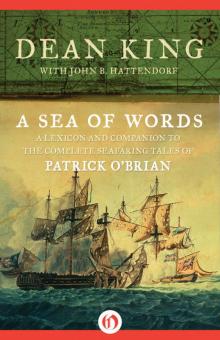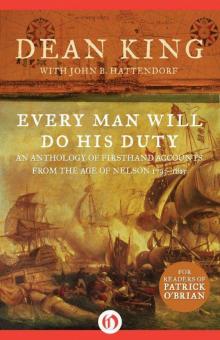Every Man Will Do His Duty Read online
Page 18
I immediately went on deck, where the second captain, who was quite a lad, caught sight of me. The tears were in his eyes, and he was greatly agitated as he asked me to hail the British frigate and say we had struck. Young though he was, the command had devolved upon him through the death of all the senior officers. Still, if he had been a veteran of a hundred fights, it would not have been in his power to continue the action any longer, nor could he have shown more proper feeling at the unfortunate position in which he was placed.
I ran to the side of the La Forte and shouted out that she had hauled down her colours, and then through the thick cloud of smoke that hung over and almost hid the vessels from each other’s view, there came back such a ringing English cheer as few are privileged to hear. I have never in my life, before or since, heard any cry like it. It filled the welkin with a glorious sound that recorded the accomplishment of a great deed, and I felt my heart beat faster and my blood go rushing through my veins in pride. Then the firing ceased, and in a short while a boat containing Mr. Vashon, the second lieutenant, and Mr. Major, the third, was lowered from the La Sybille and came to take charge of the La Forte.
The surrender of the French frigate was soon completed. I then went on board the La Sybille, which I found in charge of Lieutenant Hardyman, Captain Cook being dangerously wounded. I at once represented the probability of recapturing the Endeavour and the Mornington, which were still within sight. It was, however, impracticable to do anything then, since it was necessary to attend to the wounded and temporarily repair the more urgent damages that both ships had sustained. There were many prisoners also to be placed in safety, and these matters occupied the whole night. By morning order was restored on both frigates, and they were brought to anchor off the roads of Ballasore.
At my suggestion the French colours were now hoisted above the English on board the La Sybille, and the Endeavour lured into a position where her recapture was almost certain. But success depended upon the cant of the frigate: if she canted round one way my ship would have been placed in a situation that would have ensured her being at our mercy; but if the frigate canted the other way, there was then no room without going past the French frigate and afterward hauling up to windward for a long stern chase. Although his sailing master, Mr. Douglas, recommended the course I proposed, Lieutenant Hardyman, who was a very obstinate man, would not listen to it. The prize-master in charge of the Endeavour suspected something, and tacked and stood under the French frigate’s stern, where he saw enough to inform him of the true position of affairs, and at once sailed off, giving a signal of warning to the Mornington, which wore ship and followed. I then begged Mr. Hardyman to sail in pursuit, but he pleaded the damaged condition of the La Sybille, saying that the carpenter had reported her mainyard to be too badly wounded to carry sail. Having a great interest at stake, I earnestly pressed him to reconsider his decision, and urged in seamanlike phrase that crowbars or fishes might be lashed on to the yard for a makeshift, and there being a large property to be recovered it was worth the trial, as the frigate with her mainsail set would certainly keep pace with the Endeavour. But he would not listen to me, and I had the mortification of seeing my own ship escape before my eyes. It meant a loss to me of £10,000 in property uninsured and certainly an indirect one of double that amount by the capture of my vessel at a time when tonnage was scarce, much work to be done, and no other craft to be obtained. The Endeavour was a ship of the best class, suitable for transporting troops and just the kind the government sought for, and there was a certainty, had I recovered her, of my being engaged at a very high freight, for the expedition then being sent to fight Buonaparte in Egypt.
In this celebrated action, according to the returns which I obtained for the navy agent, out of three hundred men on board the La Forte, fifty-five were killed, including the fine old admiral, the captain, and the first, second, and third lieutenants, and eighty-five wounded. On board the La Sybille there were only fifteen killed and wounded, the fire from the La Forte having gone clean over the heads of her crew, and never been brought to bear properly upon the deck. But amongst these were Captain Davis (an aide de camp to Lord Mornington), who was on board as a volunteer in command of the Scotch Brigade, and who died of the wounds he received; and Captain Cook, who also succumbed some months later at Calcutta,4 and was accorded the honour of a public funeral. The engagement was one of the sharpest and severest that had taken place during the war, and was begun and ended in one hundred minutes.
THE TIMES of August 3, 1799, has the following leading article referring to the incident mentioned in the text:—
“Advices have been received at the India House of the capture of the following country ships in the Bay of Bengal: Recovery—McKinley; Yarmouth—Beck; Earl Mornington—Cooke; Chance—Johnson; Endeavour—Eastwick; Surprize—Moore; and two others, names unknown. The first has been sent to Madras as a cartel. They were captured by the La Forte, frigate.
“We have the satisfaction to state that the Sybille, frigate, Captain Cook, afterwards fell in with and captured La Forte, after a severe engagement. The French frigate did not strike her colours till after she had lost her captain and all her officers. When the ship struck she was in possession of a boy. La Forte mounted fifty guns, and was full of men. We consider her capture to be fully an equivalent for the loss of all the ships she had just before taken.
“The La Forte was commanded by the famous Admiral de Serci, a pupil of Suffreins, and certainly the most active and distinguished officer in the French service. Whilst the East India Company have to rejoice at getting rid of so formidable an enemy, every man must lament the fate of a very brave officer. He had the character of great humanity towards those whom the chances of war threw in his path.
“Captain E. Cook, who commanded La Sybille, is likewise well known in the service. He is the son of the famous navigator of that name, and the officer who undertook the hazardous negotiation between Lord Hood and the magistrates of Toulon, previous to our fleet taking possession of that town and harbour. We are sorry to learn that he is dangerously wounded in both arms. Our loss is very small as to men.”
On the 5th of August, The Times gives further particulars of this action:—
“The following are some further particulars respecting the capture of La Forte frigate. Captain Cook on arriving at Madras in La Sybille, 44 guns, received information that La Forte of 55 guns, 24-pounders, had taken several of our ships, and was cruising in the Bay of Bengal. He instantly went in search of her. They met in the night near Ballysore. La Forte mistook La Sybille for an Indiaman, and fired some random shots to bring her to, one of which unfortunately killed Captain Davis, aid du camp (sic) to Lord Mornington. Captain Cook approached without showing any lights, and first undeceived the enemy by a broadside. During an action of an hour and a half, the French officers did everything that was possible to keep their people at their guns, but our fire was tremendous, and the slaughter great. All the French officers were amongst the killed before a lad, who had for some time commanded, finding further opposition fruitless, struck his colours.
“The La Forte was laid down for a 74, and is perhaps the largest and finest frigate in the world, carrying her guns four feet higher than the Victorious. Admiral De Sercy (sic), on returning lately from Batavia, married a Creole lady, with whom he obtained a large fortune.”
Lieutenant Hardyman was given command of the Forte, an appointment that was ratified by the Admiralty promoting Hardyman to post-captain.
Back in the Mediterranean, in February 1800, a French squadron flying the flag of Rear-Admiral Perree sailed to relieve the garrison of Valetta, Malta, then besieged by Maltese troops and blockaded by Admiral Nelson. Nelson intercepted the squadron, and Perree, on board the Généreux (74), one of the two French ships of the line to escape Nelson at the Battle of the Nile, was killed in the process. The dubious honor of carrying the much-battered prize safely into Port Mahon, Minorca, fell to a high-spirited lieutenant named Cochrane. Afte
r battling fierce storms, Cochrane succeeded. He was promoted by Admiral Keith to the rank of master and commander and was appointed to the command of the brig Speedy.
1 La Prudente, 30 (pierced for 42): Taken by the Daedalus, 32, H. L. Ball, after an action of 57 minutes, Cape of Good Hope Station, February 9,1799. (Steel’s Naval Chronologist of the War, p. 20)
2 La Preneuse, 44: Run on-shore near Port Louis, Isle of France, by the Tremendous,74, J. Osborn, and Adamant 50, W. Hotham, and destroyed by the boats of those ships under Lieut. Gray, of the Adamant, December 11. (Steel’s Naval Chronologist of the War, p. 22)
3 La Sybille was commanded by Captain Edward Cooke, no relation to Captain James Cook, the famous explorer. Eastwick seems to have gotten much of his incorrect information from the attached newspaper article, which was printed with his account (see p. 117).
4 Captain Edward Cook [should be Cooke throughout] died at Calcutta on the 23rd of May following. There is a striking monument in Westminster Abbey erected to his memory by the East India Company. It bears a fine relief representing the La Forte and La Sybille in close action, surmounted by a bas-relief of Captain Cook, who is depicted as wounded and supported by one of his men. This monument which is immediately behind one erected to the memory of General Wolfe, the hero of Quebec, bears the following inscription:—“Erected by the Honourable East India Company as a grateful testimony to the valour and the eminent services of Captain Edward Cook, commander of His Majesty’s ship Sybille, who on the 1st March, 1799, after a long and well-contested engagement, captured La Forte, a French frigate of very superior force, in the Bay of Bengal, an event not more splendid in its achievement than important in its results to the British trade in India. He died in consequence of the severe wounds he received in this memorable action, on the 23rd May, 1799, aged 27 years.”
Thomas Cochrane
The Audacious Cruise of the Speedy
1800–1801
A HEADSTRONG SCOT, THOMAS COCHRANE entered the Royal Navy at age seventeen as a midshipman on board HMS Hind, commanded by his uncle, Captain Alexander Cochrane. Of course, his name had been carried on the books for some years before, which would have guaranteed him early promotion had it not been for his tempestuous nature. In 1798 he served on board HMS Barfleur, the flagship of Admiral Lord Keith, and in 1800, after bringing Nelson’s recent prize, the Généreux, into Port Mahon, was given his own command. It doesn’t take Cochrane long to prove himself one of the fightingest captains in the Royal Navy. In fact, his exploits would inspire generations of future novelists. Here is his own account of the legendary David-and-Goliath action between the Speedy and the El Gamo.
THE SPEEDY WAS little more than a burlesque on a vessel of war, even sixty years ago. She was about the size of an average coasting brig, her burden being 158 tons. She was crowded, rather than manned, with a crew of eighty-four men and six officers, myself included. Her armament consisted of fourteen 4-pounders!, a species of gun little larger than a blunderbuss, and formerly known in the service under the name of “miñion,” an appellation which it certainly merited.
Being dissatisfied with her armament, I applied for and obtained a couple of 12-pounders, intending them as bow and stern chasers, but was compelled to return them to the ordnance wharf, there not being room on deck to work them; besides which, the timbers of the little craft were found on trial to be too weak to withstand the concussion of anything heavier than the guns with which she was previously armed.
With her rig I was more fortunate. Having carried away her mainyard, it became necessary to apply for another to the senior officer, who, examining the list of spare spars, ordered the foretopgallant-yard of the Généreux to be hauled out as a mainyard for the Speedy!
The spar was accordingly sent on board and rigged, but even this appearing too large for the vessel, an order was issued to cut off the yard-arms and thus reduce it to its proper dimensions. This order was neutralized by getting down and planing the yard-arms as though they had been cut, an evasion which, with some alteration in the rigging, passed undetected on its being again swayed up; and thus a greater spread of canvas was secured. The fact of the foretopgallant-yard of a second-rate ship being considered too large for the mainyard of my “man-of-war” will give a tolerable idea of her insignificance.
Despite her unformidable character and the personal discomfort to which all on board were subjected, I was very proud of my little vessel, caring nothing for her want of accommodation, though in this respect her cabin merits passing notice. It had not so much as room for a chair, the floor being entirely occupied by a small table surrounded with lockers, answering the double purpose of storechests and seats. The difficulty was to get seated, the ceiling being only five feet high, so that the object could only be accomplished by rolling on the locker, a movement sometimes attended with unpleasant failure. The most singular discomfort, however, was that my only practicable mode of shaving consisted in removing the skylight and putting my head through to make a toilet-table of the quarterdeck.
In the following enumeration of the various cruises in which the Speedy was engaged, the boarding and searching innumerable neutral vessels will be passed over, and the narrative will be strictly confined—as in most cases throughout this work—to log extracts, where captures were made, or other occurrences took place worthy of record.
“May 10.—Sailed from Cagliari, from which port we had been ordered to convoy fourteen sail of merchantmen to Leghorn. At 9 A.M. observed a strange sail take possession of a Danish brig under our escort. At 11:30 A.M. rescued the brig and captured the assailant. This prize—my first piece of luck—was the Intrépide, French privateer of six guns and forty-eight men.
“May 14.—Saw five armed boats pulling towards us from Monte Cristo. Out sweeps to protect convoy. At 4 P.M. the boats boarded and took possession of the two sternmost ships. A light breeze springing up, made all sail towards the captured vessels, ordering the remainder of the convoy to make the best of their way to Longona. The breeze freshening we came up with and recaptured the vessels with the prize crews on board, but during the operation the armed boats escaped.
“May 21.—At anchor in Leghorn Roads. Convoy all safe. 25.—Off Genoa. Joined Lord Keith’s squadron of five sail of the line, four frigates and a brig.
“26, 27, 28.—Ordered by his lordship to cruise in the offing, to intercept supplies destined for the French army under Massena, then in possession of Genoa.
“29.—At Genoa some of the gun-boats bombarded the town for two hours.
“30.—All the gun-boats bombarded the town. A partial bombardment had been going on for an hour a day, during the past fortnight, Lord Keith humanely refraining from continued bombardment, out of consideration for the inhabitants, who were in a state of absolute famine.”
This was one of the crises of the war. The French, about a month previous, had defeated the Austrians with great slaughter in an attempt, on the part of the latter, to retake Genoa; but the Austrians, being in possession of Savona, were nevertheless able to intercept provisions on the land side, whilst the vigilance of Lord Keith rendered it impossible to obtain supplies by sea.
It having come to Lord Keith’s knowledge that the French in Genoa had consumed their last horses and dogs, whilst the Genoese themselves were perishing by famine, and on the eve of revolt against the usurping force—in order to save the carnage which would ensue, his lordship caused it to be intimated to Massena that a defence so heroic would command honourable terms of capitulation. Massena was said to have replied that if the word “capitulation” were mentioned his army should perish with the city; but, as he could no longer defend himself, he had no objection to “treat.” Lord Keith, therefore, proposed a treaty, viz., that the army might return to France, but that Massena himself must remain a prisoner in his hands. To this the French general demurred; but Lord Keith insisting—with the complimentary observation to Massena that “he was worth 20,000 men”—the latter reluctantly gave in, and on the 4th
of June, 1800, a definite treaty to the above effect was agreed upon, and ratified on the 5th, when the Austrians took possession of the city, and Lord Keith of the harbour, the squadron anchoring within the mole.
This affair being ended, his lordship ordered the Speedy to cruise off the Spanish coast, and on the 14th of June we parted company with the squadron.
“June 16.—Captured a tartan off Elba. Sent her to Leghorn, in the charge of an officer and four men.
“22.—Off Bastia. Chased a French privateer with a prize in tow. The Frenchman abandoned the prize, a Sardinian vessel laden with oil and wool, and we took possession. Made all sail in chase of the privateer; but on our commencing to fire she ran under the fort of Caprea, where we did not think proper to pursue her. Took prize in tow, and on the following day left her at Leghorn, where we found Lord Nelson, and several ships at anchor.
“25.—Quitted Leghorn, and on the 26th were again off Bastia, inchase of a ship which ran for that place, and anchored under a fort three miles to the southward. Made at and brought her away. Proved to be the Spanish letter of marque Assuncion, of ten guns and thirty-three men, bound from Tunis to Barcelona. On taking possession, five gun-boats left Bastia in chase of us; took the prize in tow, and kept up a running fight with the gun-boats till after midnight, when they left us.
“29.—Cast off the prize in chase of a French privateer off Sardinia. On commencing our fire she set all sail and ran off. Returned and took the prize in tow; and the 4th of July anchored with her in Port Mahon.

 A Sea of Words
A Sea of Words Skeletons on the Zahara
Skeletons on the Zahara The Feud: The Hatfields and McCoys: The True Story
The Feud: The Hatfields and McCoys: The True Story Every Man Will Do His Duty
Every Man Will Do His Duty 9/11...The Tragic Story of the Day that Changed America: The Terror, The Horror and The Heroes
9/11...The Tragic Story of the Day that Changed America: The Terror, The Horror and The Heroes White Slave Cop
White Slave Cop Skeletons on the Zahara: A True Story of Survival
Skeletons on the Zahara: A True Story of Survival